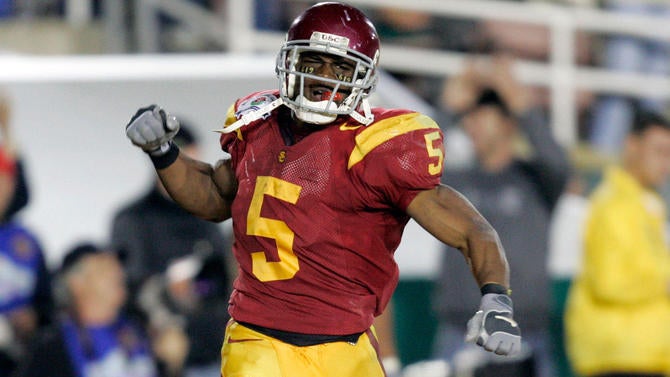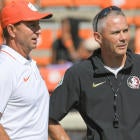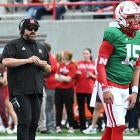The Death Penalty lives -- well, at least its legacy does.
Thirty-years after SMU became the one and only major college football program to be shut down by the NCAA, that much can’t be denied.
Saturday marks the 30th anniversary of SMU football getting The Big Haircut. Already on NCAA probation, the Mustangs became subject to the infamous repeat violator rule that was enacted only two years before SMU football was shuttered on Feb. 25, 1987.
You remember -- boosters, regents, players and coaches conspired for the most brazen, widespread pay-for-play scandals in the NCAA’s history. At least the worst that we know about.
Then-NCAA enforcement chief David Berst fainted under the bright lights of the television cameras. The NCAA never went on campus again to announce penalties.
Three decades later, we have a legacy to unpack. Books have been written. Documentaries have been produced. Football itself has become too big to fail. A television penalty -- common in the death penalty era -- hasn’t been applied to a football program since Ole Miss got hit in 1995.
Today, billion-dollar rights fees contracts would be impacted.
The college athletic world still wonders if the NCAA’s nuclear option will ever be used again.
“As long as that penalty is on the books, you can envision that penalty could always happen,” said Alabama law professor Gene Marsh, who spent nine years on the NCAA Infractions Committee.
Thirty years later, though, it’s hard to tell whether lessons have been learned or the NCAA is afraid of its own destructive powers.
In the three decades since the death penalty, there have been 50 major infractions cases involving Division I-A/FBS football programs. In the previous 30 years before that, there were 102 such cases.
Has college football been scared straight? Doubtful. BYU remains the only national champion free from NCAA sanctions in the wire service era (since 1936).
Amazingly, SMU president Gerald Turner knowingly hired Larry Brown as his basketball coach in 2012. That would be the Larry Brown who has now been in charge of three programs penalized by the NCAA (Kansas, UCLA, SMU).
“I don’t think the death penalty will happen again,” said Scott Tompsett, a veteran attorney with experience in several high-profile cases. “What kind of case would it have to be?
“I guess you could come up with a scenario, but there’s not going to be another SMU case. People are more careful. They’re not as brazen anymore. They’re more aware of the consequences.”
Because of the death penalty, SMU literally lost its place at the table as a major college football program. The Southwest Conference broke apart a few years later -- in part because of multiple NCAA scandals.
SMU was left behind when the Big 12 formed in 1996. For more than 20 years, the Mustangs have wandered through three Group of Five conferences (Western Athletic, Conference USA, American), missing out on the riches of the BCS and College Football Playoff.
SMU long ago stopped being a destination coaching job. These days, it has a middling, respectable program in a middling, respectable stadium (32,000-seat Gerald Ford Stadium). SMU has posted only three winning seasons since the death penalty.
The latest blow was missing out on the Big 12 expansion that never was.
Rival schools swept in the next day to pick off players who suddenly had no home. We didn’t see a transfer free agent free-for-all like that until current NCAA president Mark Emmert opened up the Penn State roster in 2012.
Safe to say, SMU has never recovered.
“If you need to shut down USC or Alabama, they can probably recover from that,” said Chuck Cooperstein, who covered the SMU scandal for KRLD radio in Dallas back in the day. “If you shut down SMU, they aren’t coming back. It would send a greater message if you shut down USC, Alabama or Penn State.”
The NCAA has actually gotten close to that scenario in recent years. In each case, the NCAA either considered the death penalty or applied penalties so crippling it seemed like it.
In the present day, Ole Miss, North Carolina and Baylor are possibly in line for major penalties. Those cases remain ongoing.
“I think if [the NCAA] has a similar set of circumstances, I think they would do it again,” said Danny Robbins, the former Dallas Times Herald investigative reporter who wrote some of the most compelling stories on the case.
“I can’t see how they wouldn’t.”
Given time, space and perspective, Marsh has this lasting take on the death penalty legacy:
“Imposing the death penalty is really punching the wrong dummy,” he said.
“If you are really mad at a program and a bunch of fans and boosters and trustees who have really gone over the top … you can be mean to them by making them watch a bad football team rather than no football team at all.
“Hit ‘em hard in scholarships so that they have a terribly non-competitive team. That’s more retribution and meanness.”
That actually may have been done in some form with these five schools and their programs that have come closest to the death penalty since SMU.
1. Baylor basketball, 2005: Marsh was on the COI that actually considered killing Baylor hoops in the wake of the Patrick Dennehy murder, academic fraud, unethical conduct and hidden drug positives. The basketball program was limited to conference games only in 2005-06.
“In the nine years I was on the committee, we only brushed up against [the death penalty] once, and that was in the Baylor basketball case,” Marsh said. “We actually decided to impose some form of the death penalty and backed off it … That was the closest.”
Out of the shambles of that scandal came Valparaiso assistant Scott Drew to lead the program. Today, Baylor basketball has never been better. The school’s brand, though, may never be worse with the ongoing sexual assault scandal.
2. Penn State football, 2012: The NCAA has never been good at legislating morality. It overreached in applying unprecedented penalties stemming from the Jerry Sandusky scandal. For the first time, the NCAA penalized a school with major sanctions outside the traditional enforcement route.
The negative reaction was swift and significant. The courts had taken care of the core issue -- convicting Sandusky. When the NCAA cracked down on the innocents -- the existing players -- only it could make Penn State seem almost like a sympathetic figure in the scandal. Penn State football was slapped with a four-year bowl ban and the loss of 40 scholarships. Many Penn Staters considered the vacating of Joe Paterno’s wins from 1998-2011 the ultimate insult.
At that point, what was more outrageous -- going off the reservation with unprecedented penalties or rescinding many of them two years later? (As part of that, Paterno’s wins have since been restored.) Which is it, guys?
Many think NCAA president Mark Emmert held the possibility of a death penalty over Penn State officials to get them to accept the penalties. Whatever the case, the Nittany Lions recovered rather quickly. Four-and-a-half years later, Penn State won the Big Ten and played in the Rose Bowl. Emmert hasn’t been as outspoken since that historic July day in Indianapolis.
3. Alabama football, 2002: Then COI chairman Tom Yeager famously told Alabama it was “absolutely staring down the barrel of a gun” in the infamous Albert Means case. He did not have to elaborate. Several schools jockeyed for the services of Means, a blue-chip defensive lineman. Alabama was caught in a vast scandal that included now-deceased booster Logan Young.
Repeat violator? Alabama was in the midst of four major infractions cases in 14 years. Alabama’s administration was indignant. It appealed the findings that included a two-year bowl ban and the loss of 21 scholarships over three years.
Think what would have happened had Yeager’s COI not stepped back from the brink. Alabama probably wouldn’t have been able to lure Nick Saban. The fate (and success) of the SEC in general probably would have been altered. Cooperstein was right. Like Penn State, Alabama was able to recover. Less than five years after those penalties, Saban came to T-Town. Three years after that, he won the first of four championships at Bama.

4. USC football, 2010: There have been few cases where the fallout was as vast. One player with his hand out (Reggie Bush) caused the Trojans to suffer a two-year bowl ban and lose 30 scholarships. But that was only the beginning: The BCS eventually vacated the Trojans’ 2004 national championship over the scandal. Bush gave up his Heisman Trophy from 2005. That was after the school sent back their copy of the trophy.
Evidence of one of USC’s best players winning the school’s sixth Heisman literally doesn’t exist. The Heisman Trust doesn’t list a winner for 2005. Bush’s name has basically been expunged from the USC record books. In that sense, the school essentially can’t acknowledge his existence. Bush has been “permanently disassociated.”
What’s left for some is the smoldering, hollowed out remains of any sense of fairness, anywhere, in college athletics. In the midst of the probation, Lane Kiffin -- of all people -- won 10 games. The NCAA had relied on the testimony of a convicted former felon to make its case. The subject of that testimony, former running backs coach Todd McNair, is suing the NCAA for defamation and hasn’t worked in football since.
Athletic director Mike Garrett did the program no favors taking a combative attitude throughout. A day after the penalties were handed down, Garrett curiously said critics “were just jealous.” Uh, no. Garrett was in charge of a program that somehow missed its best player touring the extra benefits sampler platter -- a house for his parents, cash, etc.
Like Penn State and Bama, the Trojans recovered rather quickly. Clay Helton became USC’s third permanent head coach in 71 months, USC’s highest rate of turnover in more that a century. But seven years after the penalties, the Trojans have averaged almost nine wins in that span (62) and made it back to win a Rose Bowl.
5. Oklahoma State football, 1989: Cowboys receiver Hart Lee Dykes became perhaps the biggest snitch in enforcement history. Given immunity -- he was allowed to play while singing to the NCAA -- Dykes put four schools on probation: Texas A&M, Illinois, Oklahoma and Oklahoma State.
Dykes testified that he had taken cash and a car with the help of former OSU assistant Willie Anderson. The Cowboys lost 20 scholarships, were hit with a three-year postseason ban and a two-year TV ban. As many as 14 boosters were involved. According to a source, Anderson played them off each other to get the best offer.
The school’s attorney, Mike Glazier, said it was only because of Oklahoma State’s cooperation that it avoided a modified death penalty -- the loss of three home conference games in 1989.
“I always thought, if he could have gotten himself a TV program, he could have raised more money than Jim Bakker or Jerry Falwell,” Glazier told me in 2008 regarding Anderson. “… He is one of the friendliest, nicest cheaters I ever came across.”
Dishonorable mention -- Miami football and basketball, 2013: USC types still steam over then-COI chairman Paul Dee wagging his finger at their program while Nevin Shapiro was running free within Miami. Had the NCAA not screwed up with Shaprio, this had the potential of being the mother of all infractions cases.
As the NCAA proudly said in the public report, there were 18 allegations involving 79 incidents. There were 118 interviews involving 81 individuals. All well and good, except the NCAA improperly used Shapiro’s testimony in a bankruptcy deposition to help make a case that was all laid out for it.
That horrible misstep mitigated the fact Shapiro had been a Sugar Daddy on steroids, running wild within the program for years. But when the NCAA screwed up, that neutered it in the penalty phase. The result was the loss of some scholarships and probation. Miami had already self-imposed a two-year postseason ban.
The intersection of a convicted felon in a New Jersey prison spawning an NCAA investigation that fell woefully short seems to be a good place to leave the death penalty’s legacy 30 years later.





















